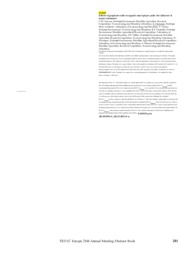Effects of graphene oxide on aquatic macrophyte under the influence of humic substances.
Effects of graphene oxide on aquatic macrophyte under the influence of humic substances.
Author(s): JONSSON, C. M.; CLEMENTE, Z.; CASTRO, V. L. S. S. de; CASTANHA, R. F.; VALLIM, J. H.; DOMINGOS, N.; BLUMEL, S.
Summary: The behavior of nanostructured graphene oxide (GO) in the environment is complex and must be completely understood to evaluate the risk involved. Studies show that humic acid (HA) can stabilize nanomaterials in water and change its behavior. The aquatic macrophyte duckweed (Lemna minor) is a good plant model for adverse effects evaluation of many test-materials due to its fast growth and small size. This study assessed the effect of GO, with and without HA, on the growth of L. minor on fronds number and biomass changes. The plants were exposed during 7 days to the nominal concentrations of GO equals to 0.0 (control), 0.1, 1.0, 10.0 and 100.0 mg L-1, in the absence or in the presence of 20 mg L-1 of HA. Tests were conducted in multiwell polystyreneplates where each well contained two fronds at the start of the experiment. The number of replicates for each test?concentration was 24 wells. The plants were exposed to a constant photoperiod (24:0, light:dark cycle) supplied by white fluorescent lamps (~700 lux) at the temperature of 20± 2 ºC. The fronds number was counted daily and the wet weight was assessed at the end of the experiment. The concentration that promoted 50% of inhibition in the growth rate in terms of fronds number (EC50-7d growth) and the concentration that promoted 50% of wet weight reduction (EC50-7d biomass) were calculated. The reduction of the growth rate by GO at the concentration of 100 mg L-1 was remarkable detected (P < 0.001) in the absence of the humic substance (HA). The HA seems to contribute with such reduction because this effect was also observed at the GO concentrations of 1.0, 10.0 and 100.0 mg L-1 in the presence of the humic substance (p< 0.01, p< 0.001 and p< 0.001, respectively). Although, the calculated EC50-7d growth for these exposures, with and without HA, was >100 mg L-1. This value attributes a practically non-toxicity for the test-material in terms of fronds production. On the other hand, the calculated EC50-7d biomass for the GO in the presence of HA or not was 2.8 and 2.4 mg L-1 respectively. These results indicate that the adverse effects of GO in L. minor are more pronounced on the biomass production since it was clearly observed that reductions in the fronds sizes were greater than in the fronds number. The EC50-7d biomass values assigns a moderate toxicity of GO to L. minor and these data may be useful for the establishment of maximum concentrations limits of this material in water bodies.
Publication year: 2016
Types of publication: Abstract in annals or event proceedings
Unit: Embrapa Environment
Keywords: Graphene, Macrophytes
Observation
Some of Embrapa's publications are published as ePub files. To read them, use or download one of the following free software options to your computer or mobile device. Android: Google Play Books; IOS: iBooks; Windows and Linux: Calibre.
Access other publications
Access the Agricultural Research Database (BDPA) to consult Embrapa's full library collection and records.
Visit Embrapa Bookstore to purchase books and other publications sold by Embrapa.

